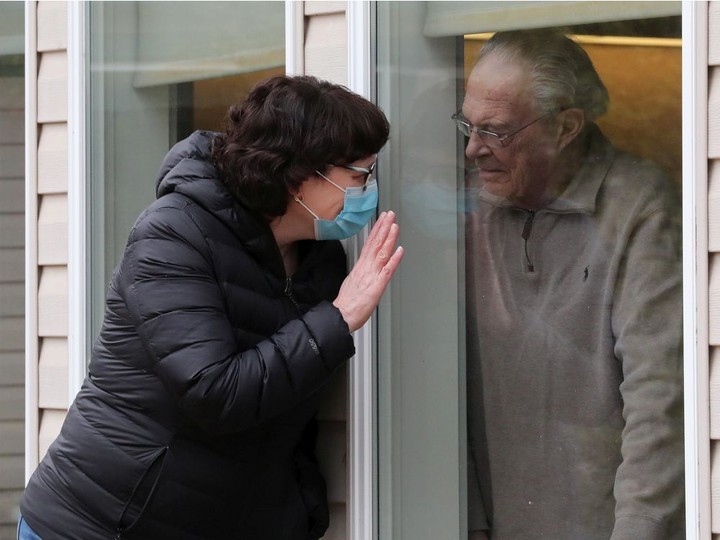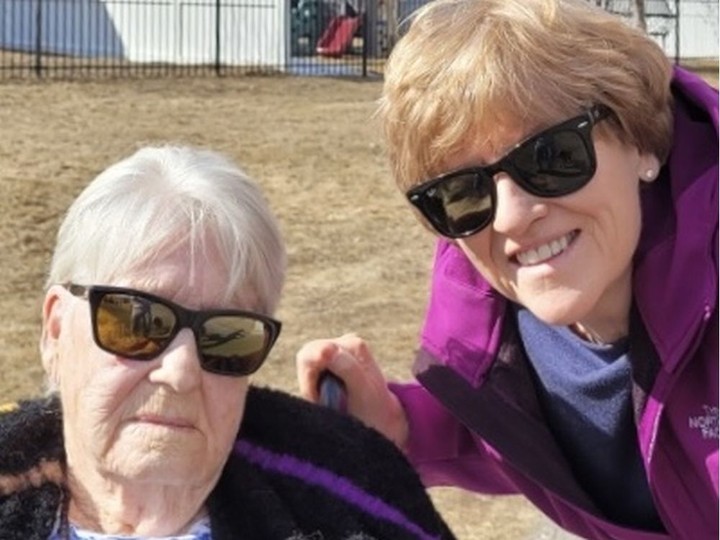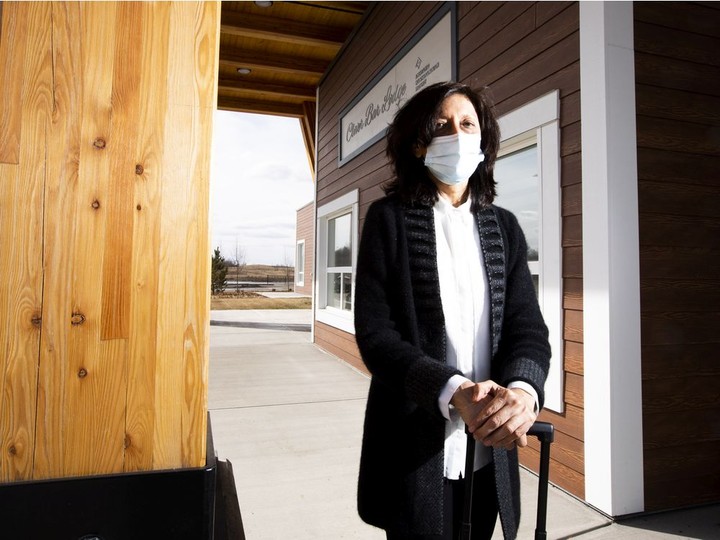treating families as 'visitors' set alberta care homes up for heartache
supports evaporated when alberta health banned "visitors" from care facilities.
we apologize, but this video has failed to load.
try refreshing your browser, or
tap here to see other videos from our team.
tap here to see other videos from our team.
by: elise stoltewhen dr. jasneet parmar’s father was in long-term care, she would visit daily, putting in his hearing aids to share world news, rubbing cream all over his skin and spoon-feeding him. she noticed his urinary tract infection; she recognized the signs when he was dying.parmar is not only a family member with hands-on experience caring for the elderly. she’s also a physician and university of alberta researcher in family-based care. with that unique set of skills, she’s been lobbying for alberta health to recognize the critical bonds cut by pandemic restrictions this year.before covid-19, family members provided up to 30 per cent of hands-on care, such as toileting and feeding, in long-term care facilities, plus emotional and cognitive support, said parmar.that unacknowledged support evaporated the moment alberta health banned “visitors” from care facilities last spring.it’s hard to quantify the effects of that dramatic move. looking at death rates, 143 long-term care residents in alberta died with covid-19 during the first wave. but many others died from other causes; these frail long-term care residents only live on average one year after admission. researchers can calculate excess death by comparing the number who died during spring 2020 of all causes (1,813 residents) and the five year average.there were 234 excess deaths that spring, according to recently-released data from the canadian institute of health information.if the real cause of death was loneliness or missing family care, we’ll never know.
globally, health advocates have come to see covid-19 and long-term care as a cautionary tale. amid the fear and chaos of the early response, many jurisdictions reversed decades of work, leaving their commitment to centre patient and family voices “hanging in the breeze,” in the words of one editorial in the british medical journal.“this was regrettable,” argued the doctors. “their input … might have prevented at least some of the excess morbidity and mortality.”canadian doctors added their voices, too. by july, chief medical officer of health dr. deena hinshaw changed the alberta orders to allow up to two family members in and deliberately called them “support persons” rather than visitors.but the issue lingered. many facility operators could not or would not accommodate resident/family access. especially as outbreaks surged again during the second wave, some operators shut down completely, limited appointments to weekday hours or made just a few spots available per week.today, residents and families still wait painfully for a promised new set of access rules.but parmar is hopeful alberta health won’t simply restore the status quo — when dedicated spouses and children were often an unrecognized, shadow workforce. “i am very optimistic that changes are coming and it’s going to be better than before the pandemic.”
- read part one: the shaky foundations of unpaid care that canada’s health care system is built on
- read part two: a ray of light even as covid-19 wreaked havoc in alberta’s home care system
- register to join our live q&a on may 4
globally, health advocates have come to see covid-19 and long-term care as a cautionary tale. amid the fear and chaos of the early response, many jurisdictions reversed decades of work, leaving their commitment to centre patient and family voices “hanging in the breeze,” in the words of one editorial in the british medical journal.“this was regrettable,” argued the doctors. “their input … might have prevented at least some of the excess morbidity and mortality.”canadian doctors added their voices, too. by july, chief medical officer of health dr. deena hinshaw changed the alberta orders to allow up to two family members in and deliberately called them “support persons” rather than visitors.but the issue lingered. many facility operators could not or would not accommodate resident/family access. especially as outbreaks surged again during the second wave, some operators shut down completely, limited appointments to weekday hours or made just a few spots available per week.today, residents and families still wait painfully for a promised new set of access rules.but parmar is hopeful alberta health won’t simply restore the status quo — when dedicated spouses and children were often an unrecognized, shadow workforce. “i am very optimistic that changes are coming and it’s going to be better than before the pandemic.”
isolation and imprisonment
through groundwork, the edmonton journal’s pilot project in engagement journalism, families came forward to talk about the isolation, lack of voice and feelings of imprisonment.advertisement

gregory bounds said the good samaritan site where his brother lives used to host family discussions twice a year to talk through issues and get feedback. that was replaced with letters posted online when the pandemic hit. “they just stopped. … it’s just become a precise, one-way flow of information.”linda tymchuk was supporting her father don brown in a private facility in a fourth-floor dementia ward when the pandemic hit. she couldn’t even see him at a window for months; she just knew he was suffering because he’d call her 30 times each afternoon as his anxiety increased and he couldn’t figure out what was happening.that operator never once asked for her perspective. eventually she got her dad into a facility with a ground-floor window, mcconnell place west, so he could at least see her behind glass.judy williams’s mother bette was in a public facility in calgary.but it locked down so severely, it wouldn’t even admit the paid caregiver williams hired pre-pandemic to help feed and support her mother. bette went five months without seeing family in the spring, then again in october/november and again early this year, and was often confined to her room.“only in these past two weeks have i been able to visit her outside,” said judy williams earlier this month. “i’ve kind of lost her now. some days, i don’t think she knows me and the spark is gone. the isolation really took its toll.”groundwork heard dozens of similar concerns from families, but it seems few people complained to the province.

advertisement
alberta health says 346 people submitted formal complaints about the health orders in the last year, mostly about access. investigators opened 110 files and in 25 cases found operators were unfairly restricting access by banning designated family support people from the building during an outbreak or limiting visits to weekdays.there are 46,000 beds in long-term and other continuing care facilities.
forming family councils
at the beginning of the pandemic, janet franklin stayed away from mcconnell place west, her mother’s dementia care centre. worried about bringing covid-19 into the home, she waited for scraps of information as facility operators focused all their attention on infection control.eventually, franklin decided that wasn’t good enough. she created her own, independent family council at mcconnell place.the legislation to support that was written in 2018, while the ndp were in power. they saw it as a way to increase accountability in facilities. operators are required to advertise the opportunity twice a year, attend meetings when requested and hold alternative town halls to answer questions if no families come forward to lead.there’s an online toolkit but no central agency to coach families through this, as there is with school councils.franklin, a soft-spoken activist, wasn’t sure how to begin. but she’s patient, determined and eager to build bridges. under her leadership, the council has not been combative. in fact, mcconnell staff were the ones to e-mail invitations for the inaugural meeting of the family council, convened on a june evening with a dozen families gathered on the front lawn.
advertisement
then they moved to zoom, both with and without mcconnell management present, to talk about supporting dementia patients.families have learned a lot, including how much it costs each facility — in gloves, face shields and staff time — to manage family support people under the current visiting rules.but they’ve also been able to make suggestions.“we think we’ve (given) valuable information and ideas that won’t cost money. it remains to be seen what happens,” she said, adding that funding shouldn’t be what prevents residents from having access to family.at the request of the council, mcconnell place allowed family members to remove face shields once inside a resident’s room so dementia patients can recognize them better. they also worked with families to plan for indoor social visits when that becomes possible, said nancy kindler, dementia care co-ordinator.the council allows families to hear each other’s views on risk and build consensus before approaching the facility, added kindler.“it’s not us coming in and saying ‘no, no.’ they’re having that conversation and they get a feel of other family members’ fear and need,” she said. “if more places could have a council to be that voice, it’s important.”health officials are now working on a new set of rules. this month, they asked for family and resident input through a telephone townhall. chief medical officer of health dr. deena hinshaw promised new orders “very soon.”on wednesday, alberta health spokesman tom mcmillan said new orders will be issued “in the coming weeks.”“these residents need joy, hope, and connection just like everyone else,” mcmillan said in an e-mail. “at the same time, we have moved cautiously, as evidence is still emerging on vaccines and their ability to both protect residents from variants and limit transmitting the virus to others.”health minister tyler shandro deferred questions on provincial orders to hinshaw.
acknowledging family caregivers as partners
parmar, the researcher who is also ahs medical lead for home care and transitions, said it’s not surprising that families were forgotten at first.infection control consumed all the attention, and there is no policy within alberta health services that formally describes the role families play. there’s no expectation facility operators need to do anything more than support the creation of a resident and family council.
advertisement
parmar believes the lack of formal policy is a big reason why it’s been tough to recover from the early ban.“it looked like (operators) were going to be opening the doors. (but the practical aspects of staffing, cost and procedure held them up). that’s the achilles heel,” she said. “there has to be more work done behind the scenes to actually make that happen.”some homes excel here. they consult, train and educate families on how to use gloves and masks effectively, she said. that needs to be the general expectation.hinshaw’s next set of orders will be significant because “whatever we create now has to extend beyond the pandemic,” said parmar. “this is the time now to acknowledge family caregivers as partners. you’ve got very reasonable, seasoned people are coming to the table and i think both the government and health officials are listening.”estolte@postmedia.comtwitter.com/estolte
this article is part of groundwork, an edmonton journal pilot project in engagement journalism that saw more than 700 seniors, caregivers and family members contribute through surveys and emails this winter to help shape our coverage. this was meant to ensure our reporting was focused on issues that matter most to our community, building trust and opening the work of journalism to new voices and insight.read more at edmontonjournal.com/groundwork, help us evaluate the project. our final series on covid-19 and continuing care runs tuesday through friday this week. as a final event, join us live for a q&a at noon may 4 with caregivers alberta.
this article is part of groundwork, an edmonton journal pilot project in engagement journalism that saw more than 700 seniors, caregivers and family members contribute through surveys and emails this winter to help shape our coverage. this was meant to ensure our reporting was focused on issues that matter most to our community, building trust and opening the work of journalism to new voices and insight.read more at edmontonjournal.com/groundwork, help us evaluate the project. our final series on covid-19 and continuing care runs tuesday through friday this week. as a final event, join us live for a q&a at noon may 4 with caregivers alberta.
 7 minute read
7 minute read

















